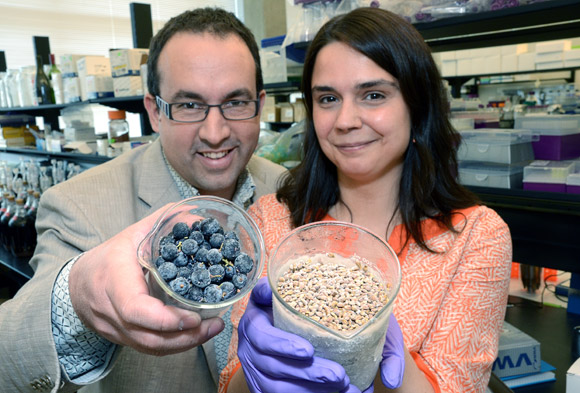
Wine researchers Cédric Saucier, associate professor and head of Chemistry at UBC’s Okanagan campus and Adéline Delcambre, a post-doctoral fellow, have discovered 14 previously unknown compounds in red wine and grape seeds.
Potential benefits for global wine industry
Two UBC wine chemists have discovered 14 compounds in wine and grape seeds that have never been previously identified – a finding with potential benefits for the global wine industry.
Cédric Saucier, associate professor and head of the Chemistry Department in the Irving K. Barber School of Arts and Sciences at UBC’s Okanagan campus and Adéline Delcambre, a post-doctoral fellow researcher in the Saucier Enology Lab, were both involved in the discovery. The results are recently published online in the Journal of Mass Spectrometry.
The research will also be presented at the international conference Macrowine 2012 in Bordeaux, France, and to the Okanagan wine industry at the 13th annual BC Wine and Grape Council Enology and Viticulture conference in Penticton.
“Our hope is that these compounds could be new markers for grape seed tannin in red wine,” says Saucier. “This means winemakers could monitor the tannin structure being extracted from grapes and fine tune their wine making.”
These subcompounds form condensed tannins that are responsible for the astringency, bitterness and aging of wines. These characteristics change from year to year, resulting in different vintage quality.
“This discovery may also improve the harvest of grapes for red wines,” says Saucier.
The phenolic compounds discovered in Saucier and Delcambre’s research are secondary metabolite elements widely present in the plant kingdom. Known as flavan-3-ol monoglycosides, they contribute to the levels of tannin in grapes and influence grape ripening. They were discovered in both Vitis vinifera L. cv. Merlot grape seeds and wine, but were not present in the wine skins.
Some of the identified phenolic compounds are typically present in pomegranates, cranberries, chocolate, cocoa, barley, rhubarb and buckwheat, but have never been identified in grapes.
The next step of Saucier’s research will determine the role the compounds play: How they affect grape ripening and how they evolve during the maceration and fermentation processes of red wine.
Their presence in both grape seeds and wine poses a significant breakthrough for vintners, Saucier says.
“This could be a quick method to find the right flavour balance between the seeds and the grape skins,” says Saucier. Winemaking involves much testing and tasting as wine ages and understanding the role of the flavan-3-ol monoglycosides could also result in a less labour-intensive process.
“It’s a mix of science and art. Testing and tasting are important, but we also want to help winemakers and provide the tools they need to produce consistently good quality,” says Saucier.
The experiments leading to discovery of the phenolic compounds in wine, grape seeds and grape skins were conducted in the Saucier Enology Laboratory in the Chemistry Department of the Irving K. Barber School of Arts and Sciences.
This research was made possible with the support of a BC Wine Grape Council (BCWGC) Agriculture and AgriFood Canada (AAFC) Developing Innovative Products grant; a Canada Foundation for Innovation (CFI) Leader Opportunity Fund grant; a Natural Sciences and Engineering Research Council of Canada (NSERC) Discovery Grant; and Agilent Technologies, equipment grant.
Further information can be found online.
The Journal of Mass Spectrometry research article
http://onlinelibrary.wiley.com/doi/10.1002/jms.3007/abstract
Macrowine 2012
https://colloque4.inra.fr/macrowine2012
BC Wine Grape Council 13th annual Enology and Viticulture conference
http://www.bcwgc.org/conference
—30—